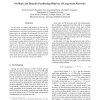Free Online Productivity Tools
i2Speak
i2Symbol
i2OCR
iTex2Img
iWeb2Print
iWeb2Shot
i2Type
iPdf2Split
iPdf2Merge
i2Bopomofo
i2Arabic
i2Style
i2Image
i2PDF
iLatex2Rtf
Sci2ools
111
Voted
ICNP
2005
IEEE
2005
IEEE
On Static and Dynamic Partitioning Behavior of Large-Scale Networks
In this paper, we analyze the problem of network disconnection in the context of large-scale P2P networks and understand how both static and dynamic patterns of node failure affect the resilience of such graphs. We start by applying classical results from random graph theory to show that a large variety of deterministic and random P2P graphs almost surely (i.e., with probability 1 − o(1)) remain connected under random failure if and only if they have no isolated nodes. This simple, yet powerful, result subsequently allows us to derive in closed-form the probability that a P2P network develops isolated nodes, and therefore partitions, under both types of node failure. We finish the paper by demonstrating that our models match simulations very well and that dynamic P2P systems are extremely resilient under node churn as long as the neighbor replacement delay is much smaller than the average user lifetime.
Related Content
| Added | 25 Jun 2010 |
| Updated | 25 Jun 2010 |
| Type | Conference |
| Year | 2005 |
| Where | ICNP |
| Authors | Derek Leonard, Zhongmei Yao, Xiaoming Wang, Dmitri Loguinov |
Comments (0)

